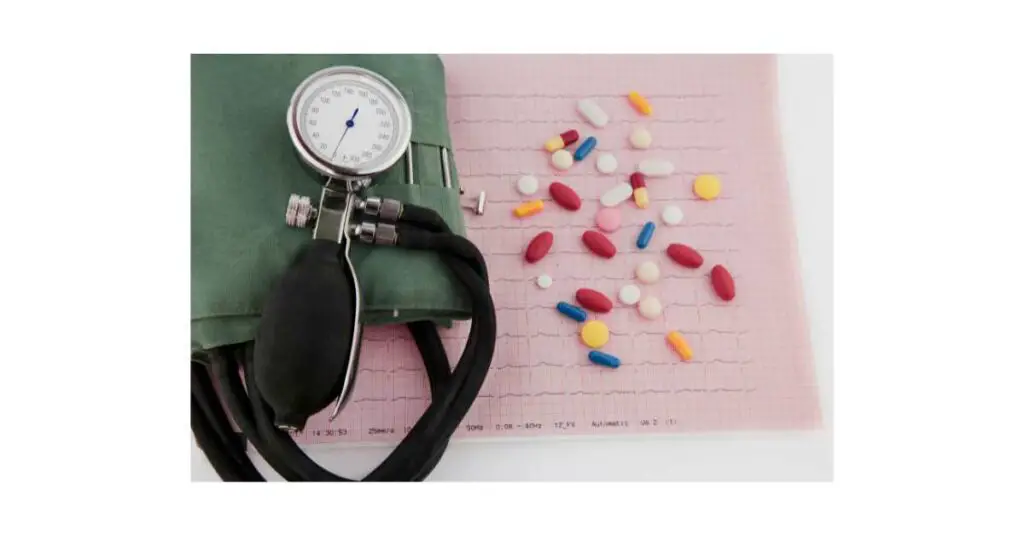Meditation has been used for centuries to reduce stress and anxiety, improve focus and concentration, and even promote physical health. But can it also be used to lower blood pressure? Studies suggest that regular meditation may help with this condition by reducing the body’s overall stress response, which in turn helps regulate blood pressure levels. In this article we will look at how meditation impacts your blood pressure, what types of meditations are best for lowering it, and tips on getting started if you want to give it a try.
Yes, meditation can help to lower blood pressure. Regularly practicing certain forms of meditation has been shown to reduce overall stress levels and cortisol production, both of which are associated with higher blood pressure levels.
Research also suggests that meditation can directly affect the cardiovascular system and improve healthy rhythms in the body’s circulation, leading to a reduction in high blood pressure.

How does meditation help you lower your blood pressure?
Meditation has long been recognized as a powerful tool for managing stress, but did you know it can also help lower your blood pressure? In an increasingly fast-paced world, it can be hard to de-stress and take time out for ourselves.
Engaging in regular meditation practice is an easy way to slow down, reduce our cortisol levels and subsequently lower our blood pressure.
It also directly affects the cardiovascular system and improves healthy rhythms in the body’s circulation, leading to a reduction in high blood pressure.
Finally, regular meditation can help build resilience against external stressors and allow you to better cope with difficult situations throughout the day, which can help bring your blood pressure back down over time.
It’s not just about calming the mind – incorporating mindful breathing into every aspect of your day gives you more control over your body’s internal mechanisms and its response to external situations. Take some time out of your day to focus on this beneficial practice and experience the physical effects in no time!
What are the different types of meditation that are best for lowering blood pressure?
There are several different types of meditation that can be beneficial in lowering blood pressure. The most commonly practiced forms include mindfulness meditation, breathing exercises, mantra meditation, yoga and tai chi.
Mindfulness meditation involves focusing on the present moment and your own thoughts and feelings without passing judgement or attaching any emotions to them. This practice can help reduce stress, improve focus and concentration as well as lower blood pressure.
Breathing exercises are another type of meditation that can help lower blood pressure. Controlled deep breathing helps to relax the body and mind, reducing overall stress levels which in turn helps regulate blood pressure levels.
Mantra meditation is the practice of repeating a word or phrase silently to yourself while focusing on the sound or meaning of the words themselves. This technique helps to clear the mind of other thoughts and is said to have calming effects on both the mind and body.
Yoga and Tai Chi are two separate practices but both involve using slow, gentle movements combined with deep breathing techniques to bring about mindfulness and relaxation. These practices not only help you relax physically, but mentally too – calming your body from head to toe.
Meditation has been found to be beneficial in many areas – it can help reduce stress levels, improve mental clarity, enhance physical wellbeing, regulate hormones and even lower blood pressure levels. So if you’re looking for a natural way to bring down your hypertension, why not give one of these meditations a try?
How long should I meditate to lower my blood pressure?
How long you should meditate to lower your blood pressure will depend on several factors, including the severity of your hypertension and the type of meditation you’re practicing. Generally speaking, for most people, a consistent practice of at least 10 minutes a day can have positive results in terms of lowering your blood pressure.
The key to seeing real results is consistency – if you make meditation a regular part of your life and practice it every day for at least 10 minutes, you’ll start to see improvements in both your overall stress levels and your blood pressure readings. And as you become more accustomed to the practice and progress with it, you may be able to increase the duration of each session over time.
When should I meditate to lower my blood pressure?
When it comes to lowering your blood pressure through meditation, timing is key. Ideally, you should meditate at the same time each day in order to get the most benefit from your practice. Doing so helps create a routine that can become second nature and makes it easier for you to maintain a consistent practice over time.
Additionally, practicing at the same time each day allows you to tap into the mental and physical state that will help bring about relaxation more effectively than if you were to switch up your timing frequently.
Meditating early in the morning or late in the evening is ideal as these are times when our bodies are naturally relaxed; however, if this doesn’t work with your schedule, it’s best to pick a time that works best for you and stick with it.
The length of your meditation sessions will depend on how long it takes you to reach a state of relaxation and focus. While 10-15 minutes is generally recommended for beginners, those who have been meditating regularly may find they can sit for longer periods of time without feeling tired or unfocused. If possible, take some time before each session to assess how much time you need – whether it’s 5 minutes or an hour – then adjust accordingly.
Finally, be sure to listen closely to your body during each session and allow yourself plenty of breaks if needed – meditating can be physically demanding and should never be done without taking proper rest breaks in between bouts of activity. With regular practice and patience, these strategies will help ensure that you get the most out of your meditation practice while also helping lower blood pressure levels over time.
Is there a meditation app that can help you lower your blood pressure?
Yes, there are a variety of meditation apps that can help you lower your blood pressure. Many of these apps offer guided meditations, breathing exercises, and relaxation techniques to assist in lowering blood pressure. For example, Headspace is an app that offers guided audio meditations for relieving stress and improving focus. It also provides sessions specifically designed for stress relief which can help lower blood pressure levels when practiced regularly.
Another popular app is Calm, which features many helpful relaxation exercises such as deep breathing, progressive muscle relaxation, and mindfulness meditations to help reduce anxiety and promote better sleep. The app also includes a selection of nature sounds and scenes to provide further relaxation while practicing the exercises.
For those looking for a more personalized approach, the Mindfulness Daily app offers an extensive library of audio meditations tailored to your individual needs based on your lifestyle and preferences. The app also includes tracking tools to track your progress over time so you can monitor how well the meditation is working for you.
Finally, if you’re looking for something tailored specifically for lowering blood pressure levels then the Meditate Now! app may be just what you need. This app helps users manage their hypertension by providing guided audio sessions on controlling stress levels, managing anger triggers and promoting relaxation techniques – all with the intention of reducing high blood pressure levels over time.
Overall, there are plenty of effective apps available that can help those looking to lower their blood pressure through meditation. Whether it’s one of the pre-made programs or something more tailored specifically to your needs, utilizing a meditation app can be an excellent way to start incorporating this beneficial practice into your daily routine.
If you find yourself struggling to stay motivated or not seeing any improvement in your readings after a few weeks of regular practice, then it’s worth speaking to a medical professional about other strategies that might help bring down your blood pressure levels. Some physical activities like yoga or tai chi might be beneficial too – they combine gentle movements with mindful breathing techniques which can help relax both body and mind.
In addition, eating a healthy balanced diet and getting regular exercise (even if it’s just taking a brisk walk twice per week) can also help reduce high blood pressure. So while meditation alone won’t necessarily cure hypertension on its own, incorporating these practices into an overall lifestyle change has been shown to have positive effects on lowering one’s blood pressure levels in the long run.
Is practicing meditation proof that you can ignore high blood pressure medication?
No, practicing meditation is not proof that you can ignore high blood pressure medication. In fact, it is important to speak with your doctor before starting any kind of meditation practice, as it may not be suitable for everyone. Meditation alone cannot provide the same level of protection from high blood pressure compared to prescribed medications and lifestyle changes such as diet and exercise.
When used in conjunction with medication and lifestyle changes, however, regular meditation can have a powerful effect on reducing hypertension. A study published in the International Journal of Cardiology showed that participants who practiced relaxation techniques for 8 weeks significantly lowered their systolic and diastolic blood pressure readings compared to those in the control group.
Additionally, another study conducted by the American Medical Association revealed that people who meditated regularly also reported fewer cardiovascular events like heart attacks or strokes than those who did not practice any form of relaxation therapy over a four-year period.
The key to successfully harnessing the benefits of meditation is to make sure that you are doing it correctly – finding a quiet environment away from distractions helps keep you focused during each session. Additionally, start slowly by shortening your sessions initially and gradually increasing them over time. It is also important to monitor your stress levels and physical body during each session by allowing yourself plenty of breaks if needed – meditating can be physically demanding and should never be done without taking proper rest breaks in between bouts of activity. With regular practice and patience, these strategies will help ensure that you get the most out of your meditation practice while also helping lower blood pressure levels over time.
It is crucial to remember though that no single method – including meditation – should ever replace prescribed medicine or other treatments recommended by your doctor for managing high blood pressure levels. It goes without saying that if you are ever experiencing an emergency health situation then seek immediate medical attention instead of relying on alternative therapies like meditation which may take longer to show results.
Tips on getting started with a regular meditation practice to reduce the blood pressure
1. Create an environment conducive to meditation
Find a quiet place in your home or outdoors that is free from noise and distractions. Consider setting up candles, incense, or other aromas to help bring about a tranquil atmosphere for your practice. Make sure the room is comfortable and pleasant to be in and has enough space for you to move around in during your practice.
2. Start slowly
Begin with short sessions of five minutes or less each day and gradually increase the length of each session as you go along. Aim for fifteen minutes per day at the most and take regular breaks during longer sessions if needed. It’s also important to start off with simple exercises like deep breathing before moving onto more complicated meditations.
3. Find a style that works for you
There are many different types of meditation available, including mindfulness, visualization, chakra balancing, qigong, yoga nidra, mantra meditation, guided imagery and more – so it’s important to find one that resonates with your personality and lifestyle. Experimenting with different techniques can help you determine which ones work best for reducing blood pressure levels over time.
4. Set realistic goals
Know what kind of results you’re looking for when starting out on a meditation practice – do you want to reduce stress levels? Increase focus? Boost clarity? Pinpointing specific goals can help keep you motivated and focused on achieving them over time. This will also allow you to track your progress better by making adjustments as necessary throughout your journey.
5. Get support from others
Joining a local meditation class or joining an online community are both great ways to get support from fellow practitioners while staying accountable with regards to your own progress regularly practicing meditation alone can feel overwhelming at first so having someone guide you through the process can really help make it enjoyable in the long run!
6. Incorporate other healthy habits into your routine
In addition to regular meditation practices it’s just as important (if not more so) to incorporate other healthy habits such as eating balanced meals containing nutritious foods like fresh fruits and vegetables; getting plenty of sleep; engaging in physical activities like walking and swimming; drinking lots of water throughout the day; avoiding processed food that is high in sugar and preservatives; limiting alcohol intake; managing stress levels; quitting smoking; maintaining an active social life — all these can play an integral role in helping manage hypertension levels naturally over time too!
Conclusion
In conclusion, meditation is a powerful tool for managing high blood pressure levels over time. However, it shouldn’t be used as an alternative to prescribed medication or other treatments recommended by your doctor and should always be practiced in combination with healthy lifestyle habits like eating nutritious foods, getting enough sleep and physical activity. By following our tips on how to get started with regular meditation practice you will soon find yourself reaping the rewards of this ancient tradition – including lowered blood pressure!




